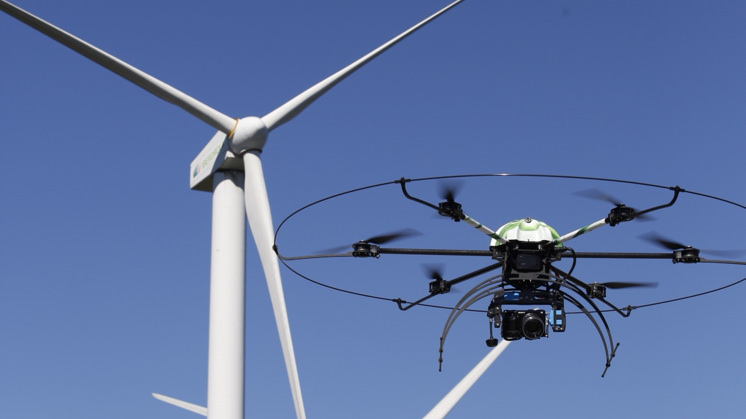Inspection with drones
We are committed to using drones to inspect wind farms
This technology makes it possible to detect structural incidents in wind turbine blades and serve as a guide during maintenance, saving considerable costs and increasing safety. Drones help us to meet our goals of extending the life of our facilities and increasing the efficiency of our more than 12,000 wind turbines worldwide.
Iberdrola and the use of drones. Video voice transcription [PDF] External link, opens in new window.
Iberdrola was one of the first energy companies to realise the enormous opportunities offered by drones.
The rapid development of these remotely piloted aerial systems has led to an increased number of applications, and the company has not hesitated to promote their use in different areas. Since 2013 it has been promoting the development of this type of technology by investing, through its international PERSEO programme, in the company Arbórea Intellbird External link, opens in new window. in order to create dedicated solutions for the revision and maintenance of wind turbines.
External link, opens in new window. in order to create dedicated solutions for the revision and maintenance of wind turbines.
THE ARACHNOCOPTER COMBINES DESIGN AND EFFICIENCY
The Arachnocopter, a multirotor folding helicopter that has revolutionised the inspection of wind turbine blades, was a result of this collaboration. Equipped with high definition cameras and other sensors, it is capable of generating, after just seven minutes of flight, an internal X-ray of a turbine's blades and detecting structural problems, such as corrosion or hot spots.

The latest Arachnocopter model, introduced in May 2018, incorporates significant improvements over its predecessor:
- It can fly longer distances along power lines.
- Its Power Grids software allows it to process and transmit the digital maps created in real time.
- The associated Power-eye app helps technicians to locate defects easily via their mobile phone.
These features maximise efficiency during wind farm maintenance inspections, reducing downtime and achieving a level of detail far superior to that of traditional inspection methods. In the last two years alone, these drones have thoroughly audited more than 1,200 Iberdrola onshore wind farm blades in Spain and Mexico.
All the information provided by the drones is analysed and stored for automatic fault management — based on artificial vision and intelligence —. This predictive maintenance allows us to extend the useful life of our wind turbines.

DIGITAL ANALYSIS OF OFFSHORE WIND STRUCTURES
In 2021, the arachnocopter has been integrated into an innovative programme External link, opens in new window. for the digital analysis of offshore wind structures that improves the inspection of wind farms during their operational and maintenance phases. The information collected from the drone flights is integrated into a new inspection technology based on digital reconstruction and analysis of the critical parts of these structures (joints and welds).
External link, opens in new window. for the digital analysis of offshore wind structures that improves the inspection of wind farms during their operational and maintenance phases. The information collected from the drone flights is integrated into a new inspection technology based on digital reconstruction and analysis of the critical parts of these structures (joints and welds).
This analysis has now been applied in a novel way on the turbine bases (jackets) in East Anglia ONE, Iberdrola's largest wind farm and one of the largest in the world, offering greater traceability and inspection safety. This procedure allows, on the one hand, the entire surface of critical elements to be mapped and analysed, which is effectively monitored by certifiers, and, on the other hand, it serves as a reference for improving the design of the operation and maintenance plan.
ADVANTAGES AND BENEFITS OF USING DRONES
Using drones to inspect and maintain windfarms offers three fundamental advantages:
- Cost savings, thanks to the use of an entirely digital platform.
- Fewer workplace accidents, as workers do not have to go up onto the facilities themselves to carry out inspection tasks at a height.
- Continuous improvement in service, due to the increase in the reliability of the equipment.
Due to the good results that the use of this type of technology is demonstrating, Iberdrola is working to expand the range of possibilities in the use of drones. It has undertaken several pilot projects to inspect telecommunications towers and hydraulic infrastructure channels at hydroelectric power plants.





